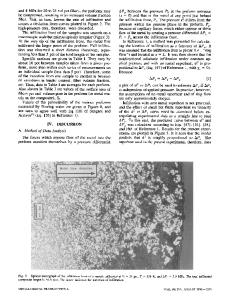Lorentz force infiltration of fibrous preforms
- PDF / 2,484,147 Bytes
- 13 Pages / 597.28 x 785 pts Page_size
- 89 Downloads / 429 Views
I.
INTRODUCTION
M A N Y processing methods have been used for the production of metal matrix composite materials. These have been reviewed by several authors I~-5] and comprise solid state processes, most notably powder metallurgical or diffusion bonding techniques, as well as solidification processes, which include dispersion, in situ precipitation, metal spraying, and infiltration processes. Infiltration, which consists of the invasion by flowing liquid matrix of a preform of the reinforcing phase, is one of the most economical of these processes. One difficulty in infiltration processing of metal matrix composites results from the poor wetting of many reinforcement phases of engineering interest by desirable matrix alloys. Adverse wetting must then be overcome either by changing capillary forces using chemical means or by propelling the metal into the preform using external force. Chemical means of enhancing capillarity generally have deleterious effects on resulting composite properties, so the metal is generally pressurized by means of a piston or by using pressurized gas. In both cases, sufficiently high hydrostatic pressure is applied to the
RICHARD M. ANDREWS, Consulting Engineer, is with TEMAV, Centro Ricerche Venezia, Venice, Italy. ANDREAS MORTENSEN, Alcoa Associate Professor, is with the Department of Materials Science and Engineering, Massachusetts Institute of Technology, Cambridge, MA, 02139-4307. Manuscript submitted April 17, 1991. METALLURGICAL TRANSACTIONS A
metal to overcome capillary resistance and feed solidification shrinkage. In all conventional pressure infiltration methods, therefore, the metal must be contained in some kind of pressure vessel. While this is not a drawback if the part is small and would ordinarily have been die-cast or squeeze-cast, continuous production of large sections is difficult. One patent by Atsushei proposes a method for the production of semicontinuous squeeze-cast sections reinforced with aligned continuous fibers. 16] In this modified squeeze-casting process, a fiber bundle is pulled through a cavity in the squeezing piston and the infiltrated composite is withdrawn through an orifice at the other end of the squeeze-casting chamber. This process has not come to commercial fruition, in all likelihood because of the difficulty in feeding fibers and retrieving a composite against the friction that results from the requirement of a solid metal seal between the highly pressurized metal and the ambient atmosphere at the inlet and outlet of the apparatus. The process introduced here eliminates the need for a pressure vessel in metal matrix composite infiltration by utilizing electromagnetic body forces to propel liquid metal into the preform material. This renders high strength pressure vessels unnecessary, providing free access to the infiltration zone during the process. Liquid metal and reinforcement can then be continuously fed into the infiltration zone, while infiltrated composite is withdrawn through a chill to produce continuous sections of composite. VOLU
Data Loading...










